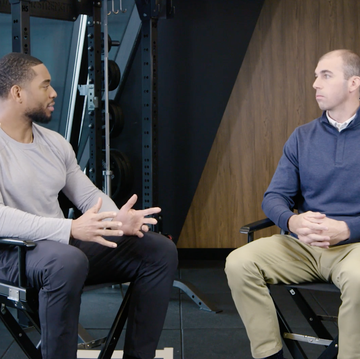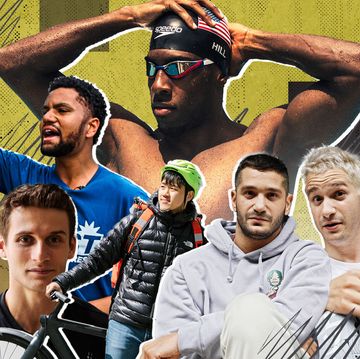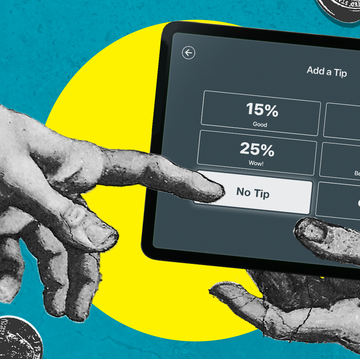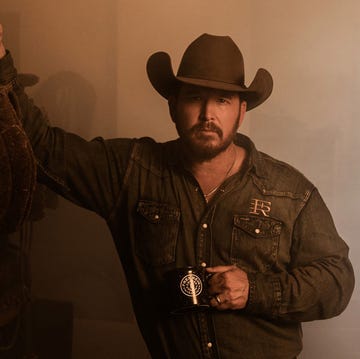Tom Brady watches 17 hours of film a week.
Want to understand why Forbes recently ranked him as the 11th-highest-paid athlete on the planet? And again recently ranked him and his dazzling wife among the world's most powerful couples, one step above the Clintons?
Do like he does. Watch the film. The answer is written all over it.
Tom Brady stalking the field, features drawn together in a dark triangle. Licking his fingertips like a card sharp before laying down aces. Standing tall after the snap, lancing a pass through the D. Even the way he ambles around between plays, under the eyes of millions, like a bathrobed playboy walking thoughtful circles in his living room. Then he barks an audible and jabs another knife into the defense's green hide.
Zoom in anywhere. Take last year's game against the 49ers: 35 degrees, a wintry mix slicking the field, the Patriots down 31-3 in the third quarter. Brady takes the ball at the Pats' 27 and goes to work, throwing it so fast and accurately that you scarcely see it arrive. Eleven plays later, touchdown.
Okay, zoom tighter. Fourth quarter, the 28-point lead reduced to 7. First and 5 at the Niners' 6-yard line. The snap. Brady reads for just shy of three seconds and then bolts up the middle. Five yards later he gets pulped by a quarter ton of Niner stopping power. It's gotta hurt. But hang on; wait for the replay. There. See that?
He's smiling.
Brady remembers that play. And countless others. His memory is eidetic—accurate, vivid.
"I don't forget many things," he says (like that final score, a 41-34 loss). "The way the weather was, the way the wind was blowing, the color of the sky. . .I'll say, God, you know, we ran this play, P130-Pump-Toga in Buffalo in 2007, toward the closed end, and it was about the third quarter of the game. And I go back in our film library and look it up, and that's exactly what it was: the name of the play, the hash that we were on, the way the defense lined up."
Traffic is light on I-95 as Brady reclines behind the wheel of his Lexus, his $30 million body cradled by the $135,000 car. His cereal-box jaw is stubbled and his eyes slow-blinking, like a jaguar's in the shade. His voice is low and resonant inside the vanilla-scented cabin. There's a languor to his California drawl that reminds you of what must have fooled every football coach in the nation at that infamous 2000 draft, which went six rounds and 198 picks before the Michigan quarterback was chosen.
Then he turns those jaguar eyes on you, the same eyes he uses to eviscerate the best defenses in the NFL; and you'd better be there, you'd better be as real and as true as he is.
The burn of Brady's gaze, like his extraordinary memory or the smile that lit up his cage on the Niners' 1-yard line, is just one of the "intangibles" that coaches like to talk about, those elusive qualities that can't be measured by ham-handed sports metrics. Metrics like the vertical jump: "I don't do one vertical jump in a game," Brady says, "but in the Combine that's what they measure."
It's not easy to detect in those dreary postgame press conferences, but in person Brady displays a certain learned skepticism about the system he inhabits. It's not that the system is stupid. It's that no system, no matter how sophisticated, will ever be able to grasp all the intangibles. What gives Brady his edge is that early in his career he interpreted this deficiency for what it was. Not an injustice but a tremendous opportunity—to be underestimated. Ask anyone. Ask Sun Tzu. Ask Captain Kirk. There is no greater psychological advantage.
Intangibles aren't unique to football players. We all have them, whatever our calling. Mental toughness. Initiative. Vision. It's easy to neglect these qualities, even in ourselves, simply because they're internal and hard to quantify. By the same token, we often overstress qualities that are easily measured (a firm handshake, the right haircut) but that by themselves will never win you the game.Brady sees this all the time. Take running.
"In the off-season, everyone runs straight ahead," he says. "All day long, straight-ahead running. Hundreds. Gassers. Sprints. And how many times on a football field are you running straight ahead? Never!"
The same reasoning explains why Brady pays so little attention to stats. "There's one stat that matters," he says, "and that's wins."
Well, games started in a row is pretty cool too, he allows. "Knowing that your teammates can depend on you every single week is a really important thing. I mean, how good are you if you play eight games a year for your team?"
And here's where you stumble across the first Brady paradox. In him you find the consummate team player; yet he's driven by a secret iconoclasm. He works the system but still stands outside of it somehow. In part this is by necessity. In the NFL, you have the head coach and position coaches, but no single staff member is expressly assigned to fine-tune players' throwing mechanics. So the quarterbacks are compelled to develop their own unique training regimens.
But there's something else at work here. Something deeper. Something. . .intangible.
Ann Arbor, 1998, off-season. A noodly blond kid walks into Greg Harden's small, windowless office in the medical wing of Schembechler Hall and says he thinks Harden can help him. Now, this is not the kind of customer that Harden, then an assistant athletic director at Michigan, usually sees. Most athletes come to him only when ordered to, and even then they insist on dragging several suitcases' worth of attitude in with them.
This kid was different. The only thing he brought into the room was himself.
It was a difficult time for Brady. First the coach who'd recruited him left, and then the head coach was fired. He had fought his way up the depth chart, but a spell in the hospital from an attack of appendicitis had left him underweight and assailed on all sides by doubt. And a hotshot freshman was arriving on campus to challenge him.
This much of the legend is known. What is not known is the story Harden told Brady. It was the perfect story, at the perfect time, and somehow Brady knew to come to Harden to hear it. The story concerned Desmond Howard, the receiver Harden had counseled a few years earlier.
Howard used to come in and complain about how quarterback Elvis Grbac never threw the ball right on the money. It was always just a few maddening inches off, so he always had to lurch around to catch it. Harden told Howard to take a breath and see Grbac's wavering aim for what it was: a once-in-a-lifetime chance to demonstrate his epic skills as a receiver.
Okay, Howard said, and two years later he took home the Heisman trophy.
"That clicked for me," Brady says. "It's like. . .when they make it the hardest, and you still overcome it, that's the best opportunity."
At that point the solution became simple. And the harder they made it for him, the simpler it became. If Brady got only three reps at practice, he simply needed to nail each one.
"And that's how it snowballed for me," Brady recalls. "Finally, all my teammates were like, 'Coach, why is Tom out? Every time he's in good things are happening.'"
Brady was not the only player Harden shared the Desmond Howard story with, but for some reason Brady was able to hear it. "I only did for Tom what Tom allowed me to do," Harden says. "He was fascinated with the stuff that I was talking about. Intrigued by it. And then bought into it and took it to the next level."
This readiness to hear and integrate constructive feedback was what marked the beginning of Brady's ascent. In fact, it may be his most prized skill: his coachability. "It was Tom's family that set this tone," Harden opines. "He respected everyone. And you could tell. And if he thought you could help him, he would use you."
Even today, Brady makes a conscious effort to surround himself with people who, like his family, will support him without trying to make it too easy for him. People he can trust.
"I try to learn from everybody," he says, citing teammates, coaches, and the owner. "I look for the great traits in those guys that separate them, and those are the things I try to learn from. Everybody has something to offer, especially at this level."
If you take this at face value, that someone will always be out there who can help you improve, then it's simply a matter of answering one question: How hard are you willing to work?For most of us, the calculation is not made entirely consciously. We simply reach a certain level of exertion and, like a man probing a leg of chicken on the barbecue, say, "Good enough." For Brady, this calculation is the constant object of mindful speculation. Which is why he continues to pursue new ways of eradicating his flaws, instead of simply adapting to them.
"Humble and hungry is how I describe him," says Tom House, Ph.D., the performance analyst Brady hired last year to digitize his throwing mechanics.
It's true about Brady's humility. Mention Joe Montana, for instance, and he'll balk at the comparison, despite having surpassed his childhood hero in multiple categories. (Disputants: Take it outside.) And it's not just a front. When Brady and a group of other professional and nonprofessional athletes first came to see Tom House, he spent most of his time with an aspiring 14-year-old baseball player.
Now let's be honest. This is not the ego-driven model of success we're accustomed to. Which leads us to Brady paradox number two. How can someone who's been called a "cerebral monster," "the best football mind in the game today," and "the winningest quarterback in NFL history" also be the most honestly humble person you'll ever meet?
An eidetic memory is not without its drawbacks. Take today, a warm June afternoon, the last day of OTAs—organized team activities—on the practice field behind Gillette Stadium. Brady stands next to Josh McDaniels, the QB coach, watching a long pass arc downfield, lost in that ballistic majesty. He's thinking about Randy Moss for some reason, the wide receiver the Pats acquired in 2007. And suddenly Brady's there again, at the end of a perfect season, and 71,000 voices roar from the shelved heights of the University of Phoenix Stadium in Glendale, Arizona.
Put up the film: fourth quarter, third and 20, Super Bowl. Pats at their own 16, down 3 with 19 seconds left. The snap. Brady rolls to the right to give his receivers time to get downfield. It's a long pass, maybe the longest he's ever thrown. But the ball doesn't have enough force on it. By the time Moss slows to let it catch up, the coverage is all over him.
In 2013, Brady resurfaces, newly crushed.
"I was thinking, 'Man, if I could have thrown it one yard farther, he'd have caught it, and he'd either have got tackled or run for a touchdown, and we could have won the game.' I'm thinking this six years after! And then I kind of sunk into a little spot, like a bummed-out..." For just a moment he lets himself mope. "And then I'm back in," he says, shaking it off, "and moving on."
Such is the constant stressful flexion of professional sports. The ability to manage this flexion, to navigate the highs and lows without cracking, is another of Brady's many intangibles, one that receives scant attention. Instead we glue our eyes to the physical performance—the calm in the pocket, the Mission: Impossible timing.
The fan wants to watch Brady perform. The student wants to know how he performs. And the overlooked fact is this: The mental performance is every bit as important as the physical one. It doesn't matter how much ass you kick during the day. If you can't transition into recovery mode without throwing back a few whiskeys, then your performance will deteriorate. This is how you tell the amateurs from the professionals. The professionals will ramp down as efficiently as they ramp up. The amateurs end up in rehab.
House, borrowing a term from his colleague Greg Rose, calls this the Big Brake Theory. It applies to muscles and mind alike.
"If you're a Ferrari and you can accelerate to 200 miles an hour, but your braking system will only allow you to stop at 180, if you go faster than 180, you die," says House.
Brady has trained himself to perform at top speed. But he has also evolved a sophisticated braking system that mostly revolves around the man he calls his "body coach," Alex Guerrero. If Brady is the Ferrari, Guerrero is its carbon ceramic brakes. "His mind is constantly in motion," says Guerrero, "and it's very difficult for him in the course of the season to slow that process down. And so there are meditative practices that we do to get him to slow his thought process down."
Over the past nine years, Guerrero has worked with Brady. During that time they developed a comprehensive training program involving body work, nutrition, neuromuscular programming, and brain training. "We call it the TB12 method," Guerrero says, 12 being Brady's number.
The Big Brake Theory is a key element of TB12. It's about balance. Every strength requires a counterstrength; acceleration and deceleration are equally critical. "I do a lot of band exercises because they work the accelerators and decelerators," says Brady. He'll work in sand, in water. Light weights with fast moves. "If you only train one way—acceleration, acceleration, acceleration—then as soon as you decel, that's when you'll get hurt."
It's veteran's wisdom—specific, practical—the wisdom of a man who works within the system but thinks outside of it. And Brady has seen the results for himself. "Injuries that may take a guy three weeks to get back from, I either don't get those injuries. . .or I do get them and we work them out in two or three days and I'm back on the field for practice on Wednesday."Incidentally, if you want to know what Brady will be doing for the next five to 10 years besides playing football, it's this: "I'm actually going to start a business," he says. The TB12 Sports Therapy Center, he says, will open this September at Patriot Place, next to Gillette Stadium. Ultimately he'd like to open three or four of them. This may come as a shock to those who expected Brady to start promoting himself as a political candidate. But anyone who knows Tom Brady knows that self-promotion is not his style.
"That's the last thing I want to do," Brady says, betraying a hint of exasperation. "I just want to help people. It's so frustrating for me to see athletes not being able to do what they really love to do. And I'm like, God, it's not that hard. It's really not. Guys work really hard, but if you work hard at the wrong things, you just don't get the results you want."
And here you discover something else about Tom Brady. We all know that he routinely discounts his market value for the sake of his team. But it's not just about what he's earned; it's also about what he's learned. And what he's learned, as a player whose exploits are now the stuff of legend, is too important to keep for himself alone. Now the legend wants to share. He wants to be one of those people you surround yourself with, who will push you but never lie to you. The person you can trust.
One last clip, a raw December day at Gillette Stadium. It's been a good game for him, a game in which he eclipses Vinny Testaverde, Johnny Unitas, and Drew Bledsoe in a range of categories. But look, seven minutes into the third quarter. Here's Brady, cursing like a common tennis player after leading Brandon Lloyd on an 11-yard pass by 6 inches too much. That he will go on to bury Miami 28-0 in the Pats' first shutout of the season does not, in his mind, excuse those 6 inches, because he is a man who cherishes a private sense of perfection.
"I have a vision of how I want the ball to approach a receiver," Brady says. "I could aim here [chest] and it comes in here [shoulder] and they're like, 'Hey, good throw.' And I'm like, 'Thanks.' But I know that wasn't really where I was aiming."
Now the Brady paradoxes begin to come together and resolve—how he can be at once humble and competitive, selfless and private. Because the game demands perfectionism, which requires a willingness to learn. And big egos make learning more difficult. It's not that ego is unsportsmanlike or unethical. It's that it's inefficient.
By now Brady knows that perfection and efficiency are artificial states of being. Leave perfection alone and it will degrade. "If you watch yourself every day, you won't see it," Brady says. "It's like watching a kid grow. But at some point you're gonna go, 'Shit, how did that happen?'"
Which is why Brady has someone film his mechanics every day, so he can review the footage and guard against slippage.
Tom House describes the process: "You learn to learn. You learn. And then you learn to relearn." And Brady is good at this. Early in his career, his arm would hurt every day. It didn't stop him from winning three Super Bowls. But today at 36, after working with House and Guerrero, he says, "I would say I perform at a much higher level as a player now than I did when we won Super Bowls."
Mechanics are one thing, of course. But what about the intangibles? How do you maintain the drive, the competitiveness, the fierce humility that makes it all possible? That's where leadership comes in, he says. "The better leadership skills, the better camaraderie, the better mental toughness—those all play a part in winning."
All true. But Brady has no captain to turn to. It's one of the burdens of leadership. But that's why he always carries the manifesto, as a kind of "refresher."
"I woke up in the middle of the night last year and wrote it," he says. He meant to share it with the team but in typical Brady fashion decided against it, not wanting to presume. Now he pulls it from his bag, unfolds it on the steering wheel, and—modestly, a bit like a schoolboy—quietly recites the nine points. Even the opening remarks, when Brady tells his listeners to "do with this as you please" and that he doesn't want to "waste your time," reflect his particular breed of athletic humility.
To this day, no one else has seen this document, and Brady is disinclined to make its contents public now. When pressed, he agrees to share just one of the nine points, the one addressing what it means to be a Patriot: Winning each day, whatever it takes, because we're counting on everybody.
At first it seems like he picked the one line that has the least to do with him and the most to do with the team. But then you see that the reverse is true. Because commitment to the team is ultimately what binds a leader to those he leads. That's why they listen, because they know he's not thinking about himself.
What does "perfectionist" mean? Maybe only that you care enough about what you do to want to do it better. Tom Brady cares about football. "All my thoughts on a daily basis go into how I can sustain the length of my career. What I eat. How I sleep. My levels of stress. Why? Because I love football."
This last bit he says with a pained shrug, as if his love of football were the one thing beyond his control. Tom Brady loves football so much it leaves him feeling helpless. And in this way you come to understand why it had to be Gisele. Who else but she could claim a piece of his heart when he's already given so much of it to football?
"There's really an excitement I have to do this for as long as I possibly can," he says, "even though everyone out there puts a limit. But I've always had people put limits. And I'm a person who says, 'Well, screw limits.' I'm not putting a limit on myself."
And now you hear the fighter coming out. The guy who has thrived on being doubted. It is Brady's great good fortune to live in a world richly peopled with doubters.
What is the limit, then? Could he see himself playing at 50?
"I would love it," Brady says. "If I think I can do it, then I probably will."













